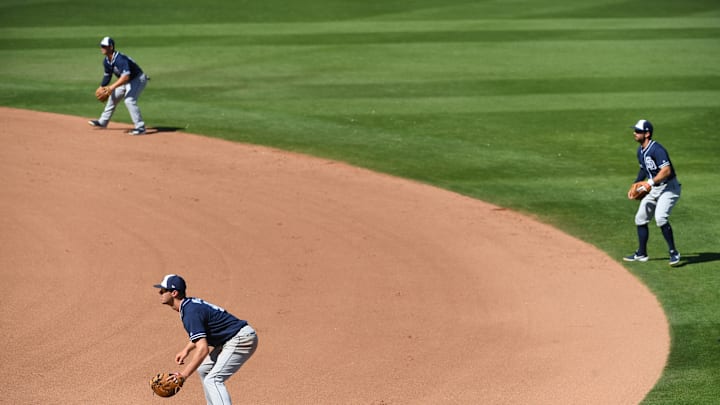One of the big topics in Major League Baseball right now is the shift. We have seen it in action for the last few years, so we have a decent sample size of how it changes the game. In this article I want to look at a few players from the Arizona Diamondbacks and see how the shift negatively affects them or in a couple cases either positively affects them or doesn't seem to affect them at all. I then want to give all of my readers my take on the shift, and how I think the shift could and should actually be used to make the game more interesting. But before we can do that I want to throw a Statcast sabermetrick term at you, wOBA.
I need to define wOBA because when I compare Diamondbacks players in the next part of the article, I will do so with this term. So, here is the explanation from the Fangraphs site itself. Weighted On-Base Average (wOBA) is one of the most important and popular catch-all offensive statistics. It was created by Tom Tango (and notably used in “The Book”) to measure a hitter’s overall offensive value, based on the relative values of each distinct offensive event.
wOBA is based on a simple concept: Not all hits are created equal. Batting average assumes that they are. On-base percentage does too, but does one better by including other ways of reaching base such as walking or being hit by a pitch. Slugging percentage weights hits, but not accurately (Is a double worth twice as much as a single? In short, no) and again ignores other ways of reaching base. Weighted On-Base Average combines all the different aspects of hitting into one metric, weighting each of them in proportion to their actual run value. While batting average, on-base percentage, and slugging percentage fall short in accuracy and scope, wOBA measures and captures offensive value more accurately and comprehensively.In baseball, wOBA is a statistic, based on linear weights, designed to measure a player's overall offensive contributions per plate appearance. The metric has 4 different classifications;Elite which is .400 and above,very good which is .371 to .399,Good which is .321 to .370 and Average which is .320 and below.
The formula for the 2018 season was:
{\displaystyle wOBA={\frac {(0.69*NIBB)+(0.72*HBP)+(0.88*{\mathit {1}}B)+(1.247*{\mathit {2}}B)+(1.578*{\mathit {3}}B)+(2.031*HR)}{AB+BB-IBB+SF+HBP}}}
Now that we got that out of the way let's look at how the shift will affect the Diamondbacks. I want to look at two hitters that if the shift goes away will positively affect the most. I want to look at one player's lefty righty splits when he is shifted on or not. And one player who the shift does not seem to affect at all. So, let's start with the player that the shift does not seem to affect. In the 2021 season on the 212 plate appearances that he was shifted on his wOBA is .312 and when they did not shift on him in .323 plate appearances David Peralta hit .315 wOBA. Looking at a Diamondbacks lefty righty split, Ketel Marte's wOBA was .339 against the shift and .345 when he was not shifted on. That was batting left handed. When he bats right handed against the shift his wOBA climbs to .638 and when he is not shifted against batting right handed he hits .446 wOBA. Now for the two hitters who will benefit the most from teams not being able to shift against them. The first is Josh VanMeter, when teams shift against him (which is 75.2% of his at bats) he only manages a .252 wOBA. But, when he was not shifted on in a plate appearance in 2021 his wOBA jumped to .390. The second hitter who has big wOBA splits when the shift is on him his wOBA is not as drastic but still measurable at .237 wOBA against and .274 when not shifted on is Nick Ahmed. To put these differences into perspective, Peralta is labeled as average, Martel is labeled as Elite against righties and good against lefties. VanMeter would climb without the shift from average to very good.

My View on the Shift
I have an idea using the shift that I believe would make the game better and make the game more strategic. There are 27 at bats in each 9 inning regular baseball game. What if we give the manager the ability to shift on 15 at bats per regular 9 inning game? He would have a card in his hand like in soccer that is red on the top and green on the bottom. We impose a 30 second "shift clock" which gives the manager 30 seconds to make the decision and get his players into the shift if he wants from the time the opposing batters name is announced. Red would mean shift and green would mean no shift. It would add intrigue and strategy to the game as a manager would need to decide if he wants to shift against a certain hitter every at bat, or only in certain situations. For example would you shift on a pull hitter if there was a fast runner on 1st base who could steal a base if the second baseman was playing out of position. Would you shift the first baseman into the second base hole if a runner was on first or hold the runner on with a traditional defense or would you move the second baseman over and basically give the runner second base. You would have options on how to guard against a bunt from a pitcher depending if there were runners on or not. And those are just to name a few.
It is like a lot of other things, don't allow the new thing to be done all the time. Don't allow the new thing to be taken away completely. Everything in moderation to add intrigue and excitement to the game.
